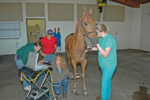Advertise Follow Us
Lamenesses
Manipulating Foot Function
While the impact of shoeing on foot function is well documented, the biomechanics aren’t as easily understood
Read More
Wire Cut, Infection Takes 7 Years of Treatment
A serious pastern injury and later infection to the sensitive lamina almost cost a Quarter Horse its life
Read More
There's More Than One Kind of Heel Pain
Farriers face heel problems almost daily, but it’s important to understand that there are different causes, requiring different approaches
Read More
Bowed Tendons: The Farrier's Role in Prevention and Treatment
Regularly scheduled hoof-care appointments and cooperation with a veterinarian are important aspects of dealing with these injuries
Read More









